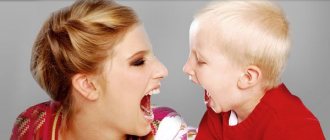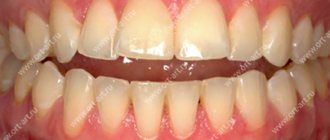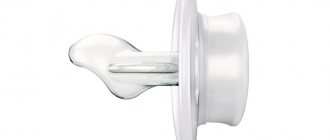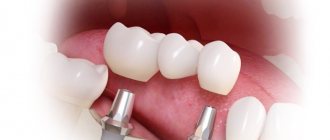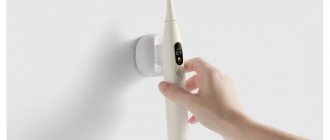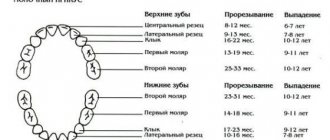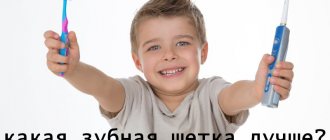23619
The formation of a person’s bite occurs in childhood before the eruption of all milk teeth.
This process is influenced by many factors - heredity, breathing problems, the position of the child during sleep.
According to most orthodontists, the use of a pacifier has the greatest impact on the development of the baby’s lower jaw and the correct growth of dental elements.
Not only the correct placement of the teeth in the jaw row, but also the further proportions of the face depend on the type and duration of its use.
Necessity or habit
From the moment of birth, the baby develops a sucking reflex, which remains very strong for up to six months. But it is of decisive importance for survival and the possibility of nutrition, therefore it is more developed than all the others. Starting from six months, it gradually begins to fade away, so the desire to constantly make sucking movements becomes a habit. Any attempts to get rid of it cause violent resistance in the form of crying. After a year, the reflex completely disappears, but the attachment to the pacifier remains, turning into psychological dependence. At the age of 2-4 years, this phenomenon already completely belongs to the category of bad habits.
Optimal age for use
Starting from the first days after birth, the baby begins to develop a sucking reflex. Innate instinct is vital for the further development of the child, as it ensures the receipt of milk from the mother's breast or bottle.
Another key purpose of the sucking reflex is to reduce motor activity of the brain and reduce the number of negative emotions.
Regular suckling of the mother's breast can reduce the baby's anxiety, promote his relaxation, and also reduce the risk of developing neurotic reactions in adulthood.
The intensity of the sucking reflex is different for each child, so in order to avoid disrupting the established diet, women often resort to using a pacifier.
The sucking instinct remains most pronounced in the first year of life. It is during this period that it performs a protective function in the baby’s body.
Using a pacifier at this stage of development allows you to achieve the following:
- distract the child from pain and discomfort;
- improve sleep;
- reduce excitability;
- eliminate the risk of tongue retraction during sleep;
- improve the bite of bottle-fed children with the correct selection of pacifiers.
Starting from 8-9 months of a baby’s life, his innate reflex gradually fades away, completely disappearing by 3-4 years.
This is due to the development of the child and the gradual transition to spoon feeding, which serves as an impetus for the development of the chewing instinct.
Therefore, most dentists and pediatricians recommend stopping further use of a pacifier during this period.
According to research, the process will bring a minimum of physiological and psychological inconvenience.
Reasons for the development of a crooked jaw and how to correct the defect.
Read here about the indications for compactosteotomy and the technique for performing it.
At this address https://orto-info.ru/zubocheliustnye-anomalii/zubov/polozheniya/etiologiya-razvitiya-i-metodyi-korrektsii-protruzii.html we will tell you what dental protrusion is and what causes it.
What's happening
When a baby sucks on a pacifier, there is a disruption in the muscular distribution of pressure on the teeth, tongue and inside of the cheeks. There is insufficient impact on the lower dentition, and the cheeks do not retract as much as when in contact with the nipple on the chest. Because of this, the mandibular bone is poorly initiated, and the pace of its development may be disrupted. In addition, due to such constant pressure, the alveolar processes are capable of shifting, which will subsequently lead to the appearance of three or diastemas.
The degree of harm is not determined by how strongly and intensely the baby makes sucking movements. The main thing is how often he does it. Using a pacifier for 15 minutes before bed is much less harmful than sluggishly sucking a pacifier or finger for six hours. From this impact, the erupted molars gradually tilt forward, which provokes the appearance of cracks. The worst effect is the constant presence of a pacifier in the mouth during night sleep.
Negative action
Despite the benefits of using a pacifier to satisfy a baby's sucking reflex, most dentists are unanimous in the opinion that long-term use of it has a negative impact on the condition of the oral cavity.
The size of the lower jaw of a newborn is significantly smaller compared to the upper. To enhance its growth, experts recommend focusing on breastfeeding, during which the lower jaw moves forward and the tongue makes wave-like movements.
When using a pacifier, the natural muscular balance is disrupted, resulting from the pressure of the tongue on the jaw line and the contraction of the muscles of the cheeks and lips during sucking.
The nipple puts pressure on the periodontium, leading to excessive stress on the mucous membrane. As a result, emerging teeth may shift into incorrect positions.
Most often, children who abuse a pacifier are subsequently diagnosed with a distal or open bite, as well as excessive forward inclination of the teeth of the upper jaw.
Pathological changes in the structure of the dentition occur if the total duration of pacifier use exceeds 6 hours a day.
If a child uses a soothing object extremely rarely, it will not cause malocclusion.
Stages of development of disorders
Long-term use of a pacifier in most cases causes violations according to the same algorithm. They appear in the following sequence:
- From 1.5 to 3 years – formation of an open bite in the frontal zone. Rarely, such a phenomenon forms in the lateral part of the dental arch. This does not happen during sucking, but if the baby constantly chews the pacifier with his side teeth.
- Around 4 years of age – a bad habit is developed in the form of sticking the tongue into the formed gap to compensate for the missing pacifier.
- From 3 to 6 – the dentofacial apparatus is being prepared for the eruption of permanent teeth. Stabilization of oral breathing due to a constantly open mouth and loss of the habit of breathing through the nose. Frequent or chronic colds of the upper respiratory tract.
- 6-8 years – stable inability to breathe through the nose and chronic adenoiditis. Severe open bite after the appearance of a permanent set of teeth.
Violation of the development of a child’s dentition often entails a deterioration in diction and articulation, and in the long term, the appearance of psychological problems and complexes due to an unattractive profile and problems with speech.
About reflexes
The nutrition of a newborn, namely the receipt of milk and its entry into the gastrointestinal tract, is carried out through two actions: sucking and swallowing. How does this happen? The milk ducts of the mother's breasts are surrounded by soft muscles that contract to release milk. To obtain milk, the baby does not need to suck it from the mother's breast, but only needs to stimulate the soft muscles so that when they contract, they release milk. During feeding, the baby makes small squeezing movements with its lips, which are instinctive actions. Once the milk enters the baby's mouth, all he has to do is lower his tongue to allow the milk to flow further into the throat and esophagus. At this moment, the tongue moves forward until it touches the lower lip.
This sequence of actions determines infant swallowing, the so-called infantile type of swallowing, in which there is an active contraction of the muscles of the lips and the orbicularis oris muscle, the tip of the tongue moves forward to contact the lower lip and upward to press the nipple to the palate.
The contact of the tongue with the lower lip is so common in newborns that it is considered a resting position. You can often notice that if you lightly tug on a newborn's lip, the tip of the tongue moves along with the lip, as if it were glued to it.
Time frame for quitting a bad habit
Ideally, you should get rid of this bad habit before the age of one year. At the age of 11-12 months, saying goodbye to this product is easiest: the reflex has already weakened, and the addiction has not yet had time to take hold. In addition, at this age, a baby’s long-term memory is not so developed, so with a high degree of probability, unlearning will take place in a few hours or a day. If the process is difficult, a new toy or rattle will help you switch your attention. In practice, not all parents are ready to take such a step regarding their baby.
In children under 3-4 years of age, compensatory mechanisms are very highly developed, so getting rid of the pacifier can return the teeth to a physiological state even without orthodontic treatment. This occurs under the force of pressure from new teeth that are erupting and the restoration of proper load on the lips and cheeks - this phenomenon is called self-regulation.
If the dependence persists at the time of the appearance of a replacement set (in some children, permanent teeth begin to erupt at the age of five or even four), then the deviations become more serious and may require orthodontic treatment of the bite.
It is advisable to begin correction only after the child is completely weaned from the pacifier, otherwise the clinical picture will return in the first months after the end of the course.
How to wean off painlessly
The process of weaning a child off a pacifier is very individual. Some children do not notice the disappearance of the rubber device from their lives, being distracted by new activities. Others, on the contrary, experience severe stress.
Many mothers, based on their own experience, note that the process is most comfortable when the baby is between 6 and 10 months old.
To make the process as comfortable as possible, you must adhere to the following recommendations:
- choose a teether when the child’s first tooth grows - this will help distract attention from the usual pacifier and speed up the teething process;
- stop using a pacifier to soothe the child - pick him up, talk to him, rock him to sleep;
- reduce the frequency of use when getting ready for bed, replacing it with a relaxing massage, reading a fairy tale, singing a lullaby;
- Remove the pacifier from the baby's mouth after he falls asleep.
If it is necessary to wean a child older than one year from a pacifier, experienced parents advise resorting to some tricks.
For example, exchange a pacifier for an interesting toy, lose it, or offer to give it to a younger friend.
The complexity of the process of weaning a child from a pacifier may depend not only on the degree of dependence of the child, but also on his physical and emotional state at a certain point in time.
Therefore, if the baby is sick or in other stressful situations, it is better to postpone giving up the pacifier to a more favorable moment.
Alternative
Round pacifiers, which have been the standard choice for generations, are currently the worst option. Now you can choose physiological nipples that have a less detrimental effect on the bite. Such orthodontic products differ from standard ones in their shape.
In addition to the classic ones, there are two types of pacifiers:
- Anatomical – does not cause deformation and narrowing of the upper palate.
- Orthodontic – promotes the formation of correct dentition, causes physiological tension in the lower jaw, which leads to its normal development and growth.
When choosing a product, you should pay attention to the following factors:
- Beveled side surface on one side. This shape follows the mirror anatomy of the oral cavity. The beveled section turns towards the lower teeth, and the convex section should face the upper palate. Physiological contours make it possible to activate the growth of the mandibular bone, as it should happen normally.
- Material. You can find latex and silicone products on sale. For the bite, the fact that latex expands during prolonged sucking is important, this causes a greater displacement of the teeth forward, therefore silicone products should be replaced more often than silicone ones.
- Size. Using products that are too small or too large is more likely to cause orthodontic problems in a child. For infants up to six months, take the first size. From six months to one year - second size. If a child was born too large and grows quickly, the transition to the next size may occur earlier.
- Air valve. In addition to such a negative aspect as swallowing air, the presence of a valve prevents the pacifier from sticking together, which leads to improper distribution of the load inside the oral cavity, chewing and facial muscles.
Early loss of baby teeth
As mentioned above, untimely loss of baby teeth can negatively affect the formation of a correct bite. Baby teeth prepare space for permanent teeth, which ensures straight teeth in older age. With the early loss of primary teeth, permanent teeth may not erupt correctly, there may be a lack of space between the molars and canines, permanent molars may move into place of the removed primary teeth, which may lead to the need for their removal in the future when permanent teeth begin to emerge. To prevent these phenomena from occurring, special devices are used - replacement devices - to help maintain space in the dentition. If several baby teeth are lost, then a removable plate is used, if one tooth is lost, then a non-removable orthodontic device is used.
If the front teeth are lost (as a result of caries or injury), then a prosthetic plate is used. Using this device, you can restore chewing function and speech, protect the periodontium from overload, preserve space for permanent teeth and prevent the displacement of remaining teeth.
Recommendations
In order to avoid problems with the child’s teeth in the future, parents should monitor the growth and formation of the dentofacial apparatus from the first year of life.
You need to adhere to the following advice from pediatric orthodontists:
- Preference should be given to an orthodontic or anatomical nipple. Ideally, you should have both types and change them daily between each other. They allow the tongue to take a natural position.
- There is no need to forcibly take away the pacifier if this causes excessive protest from the baby. In most such cases, he will begin to compensate for the product with his own fingers, and this habit causes even more problems, and it is more difficult to get rid of it.
- A serious struggle with the pacifier is appropriate from the age of 2-3, when the sucking reflex has already completely died out, and the range of interests of the little person has become wider.
In order to detect bite problems in the initial stages, when correction is easiest, you need to undergo periodic medical examinations:
- at the dentist - from one year onwards, once every three months;
- at the orthodontist - after 2-3 years, once every six months.
Now let's act like an adult
By the time of birth, the baby’s lips are well developed for active sucking activity, and the structures located deep in the oral cavity are practically not developed. Over time, the need for increased activity of the posterior parts of the tongue and more complex movements of the pharyngeal structures develops. The sucking reflex usually disappears and sequential maturation of oral functions occurs: from the anterior regions to the posterior ones.
The front-to-back principle of oral maturation is well illustrated by the process of speech development. The first sounds pronounced are the labiolabials “m”, “p”, “b”, so the first words of a newborn are usually associated with the pronunciation of these sounds (“mom” or “dad”). Some time later, consonants appear, pronounced with the tip of the tongue - “t”, “d”. The whistling sounds “ch” and “sch”, requiring the tip of the tongue to be placed close to the palate, appear even later. The sounds “k”, “g” and “r” require more precise positioning of the back of the tongue, so they may not be clear until 4-5 years of age.
As the baby grows, the activity of the muscles that raise the mandible during swallowing increases. As semi-liquid and almost solid foods are added to the child's diet, he is forced to use his tongue for more complex actions: to form a bolus of food, position it in the middle of the tongue and transfer it to the pharynx. Chewing movements of a small child usually involve a sideways movement of the lower jaw as it opens, then returns to the midline and closes to bring the teeth into contact with food. By 2–2.5 years, this method of infant chewing is already well developed. At the same time, with the help of more complex movements of the tongue in its posterior part, infantile swallowing turns into a more complex process.
The mature or adult swallowing pattern appears in some children as early as 3 years of age, but in most it is fully formed by 6 years of age and never develops in 10–15% of the population.
Orthodontic replacements
At the stage of weaning off a pacifier, a child often develops a new harmful habit - thumb sucking, and this can aggravate all existing malocclusions and cause new ones.
Orthodontists have developed several devices that can ease this period, allowing the dental arches to take the correct shape:
- Hinz records. Used from the age of 1.5 years. They can be equipped with a bite block, tongue guard or bead. Helps place the tongue in a normal position.
- STOPPI prophylactic plate. It is a vestibular silicone plate that can be used even at an early age. Due to the presence of lateral biting areas, it prevents excessive compression on the upper teeth in the frontal area. The first tendencies towards the formation of an open bite when using this plate, as a rule, disappear on their own.
- LM activator. It helps ensure that after saying goodbye to the pacifier, other bad habits do not arise, and at the same time, the normalization of the dental arches occurs.
Probably, the finger is, after all, more dangerous for children's health than the pacifier.
This is explained by the fact that the finger, larger than the tip of the pacifier, affects the territory of the oral cavity. It is also believed that it is much more difficult to wean a baby from thumb sucking - after all, it is always “at hand”, the finger cannot be taken away and hidden. The use of the pacifier can be more or less controlled - “lose”, “give to the neighbor’s puppy”.
First of all, weaning off any bad habit should under no circumstances be traumatic, either physically or psychologically. Grandmother's methods of spreading mustard or brilliant green on your finger are not recommended. Abruptly taking away the pacifier is also not justified. It is better to use unobtrusive persuasion, a game form. If necessary, consult your doctor.
Observation by an orthodontist during primary occlusion
Anomalies of the “milk” period have a negative impact on the formation of a removable and then permanent bite. If the problem is not eliminated at this age, the formation of a permanent bite will occur with disturbances, which will entail more serious orthodontic treatment. Progressive abnormalities that affect the growth and development of the jaws must be treated as early as possible. Timely orthodontic treatment, begun during the period of primary occlusion, normalizes further jaw growth and helps correct the occlusion.
Does a pacifier prevent your tongue from sticking in your sleep?
Adults have a disease - rhonopathy or snoring. It also happens in children with lesions of the central nervous system - while falling asleep, the muscles of the soft palate relax, it begins to hang over and block the upper respiratory tract. In this case, the tongue may retract and breathing may stop during sleep. Can a person suffocate this way? It’s unlikely, because during breathing disorders, nerves are activated and the brain centers are irritated by carbon dioxide, and the person either goes into a state of superficial sleep or wakes up.
In children, this condition occurs only in cases where the nervous system has not formed. Then, of course, the pacifier will be the restraining factor that will prevent the tongue from sinking. But this will in no way save the baby from drooping and overhanging of the soft palate, so such children should be observed by neurologists. We cannot say that a pacifier is their only salvation from sleep apnea.
This condition can also occur in children with an overly large tongue - for example, when there is a pathology of the thyroid gland. In this case, the pacifier will also help prevent tongue retraction.
Is a pacifier a substitute for breastfeeding?
When sucking on mother's breast, the baby makes much more effort to eat than when sucking formula from a bottle with a nipple. This is good for training the chewing muscles, which is important for the prevention of certain dentofacial anomalies. However, even prolonged breastfeeding (over two years) can become an aggravating factor and affect the formation of malocclusion.
Natalia Gorodulina (@gorodulina_psy)
Child psychologist, play therapist
When it comes to the question of whether to give a child a pacifier or not, I always advocate comfort for mother and child. You need to be guided by the situation and needs - there are children who categorically do not take a pacifier, and this is normal. And there are those who really need a pacifier - and this is also considered the norm. A tired, anxious mother who does not have the strength to smile at her baby is what is really harmful for the child. Therefore, the main advice to mothers of babies is to worry less. Trust yourself and your intuition more and, if possible, avoid sleep deprivation.
